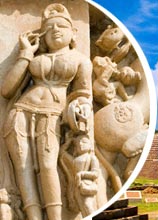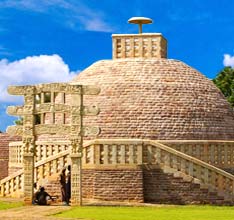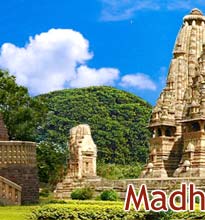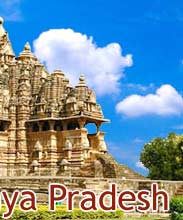Bagh Caves of Madhya Pradesh are counted amongst the
finest specimens of Buddhist art and architecture in India. Located 50
km west of Mandu, this cluster of five caves falls on the road between
Indore and Vadodara. The word 'cave' is incongruous, as these cave
sanctuaries have not been naturally formed, but are actually rock-cut
structures carved by the ancient artisans of the country. Bagh Buddhist
Caves, like the caves at Ajanta, find shape on a perpendicular rock face
of a hill.
These five Buddhist caves are situated on the bank of Baghini River and
lie approximately seven km from the village of Bagh, in the Kukshi
Tehsil of Dhar District. According to legends, before being discovered,
they served as home to many tigers. Hence, they got the name 'Bagh',
which means 'Tiger' in Hindi. Later, these caves also served as
residential places, meditation centers and religious congregation sites
for Buddhist monks.
Thus, one can notice preponderance of Buddhist mysticism in these cave
sanctuaries. There are residential cells inside, along with a large
central cell enshrining a Buddhist stupa at the back end, which served
as the 'chaitya' or prayer hall. Bagh Caves also hold numerous
sculptures of Buddha and Boddhisattvas within their precincts. A
painting of the Bodhisattva 'Padmapani' housed here exemplifies the
Padmapani figure found in Ajanta.
Apart from this legendary painting of Padmapani, there are some traces
of ancient murals and frescos by master painters of India. They exhibit
vivid imagination and inventive spurts of these ancient painters and
have striking resemblance to the paintings of Ajanta. In fact, these
paintings are just a feeble glimpse of the rich paintings and frescos
that once embossed its roofs and ceilings. Nevertheless, they are what
still entail the popularity of the Bagh Caves.
Until recently, Bagh Buddhist caves were roughly assigned to 7th
century, on the basis of their architectural style and style of
painting. However, a copperplate grants inscription traced back the date
of some of these caves to the 4th or 5th century A.D. Today, only five
of the nine caves have survived the carnage of time and they still stand
tall as one of the most marvelous vestiges of Indian rock-cut
architecture. The beautiful delineation of art that finds expression in
these caves makes them stand out as one of the most popular tourist
draws of Madhya Pradesh.









